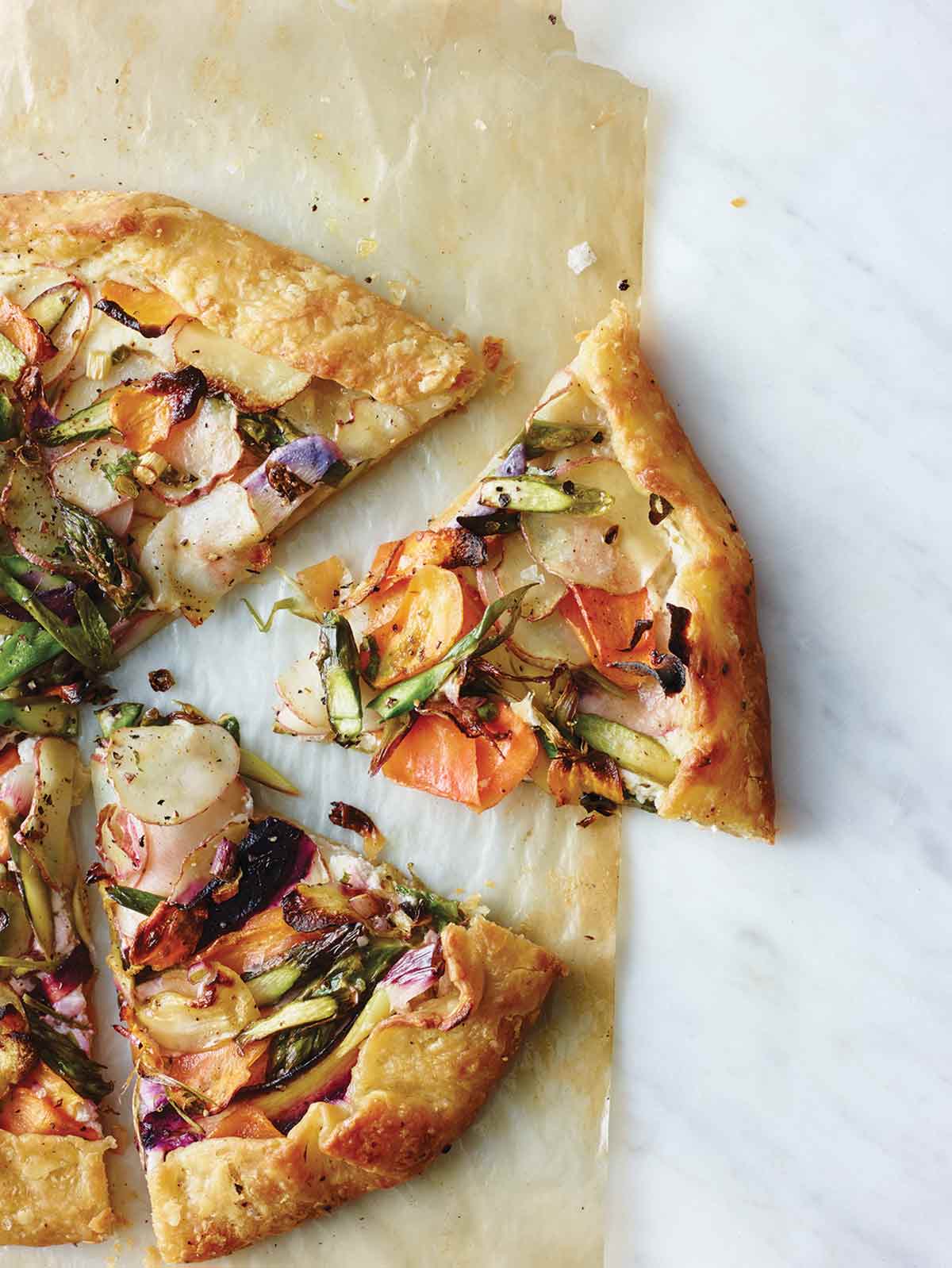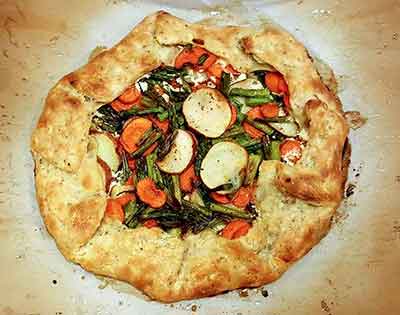
Vegetable galette. Because secretly, we all want pie for dinner. And this savory tart will convince you that pie for dinner isn’t only conceivable but doable thanks to its buttery, flaky pastry smothered with a creamy cheese sauce and perfectly roasted vegetables that are surprisingly sweet and tender. So go on. Have a second slice. After all, you’re eating your vegetables.–Angie Zoobkoff
How To Make The Flakiest Pastry
We all know that cold butter is the secret to flaky pastry. But there’s a little-known corollary to that rule. And it stipulates that you not only want to start with cold butter, but you want the butter to remain cold until the moment it hits the hot oven. To achieve that, the author of this recipe grates the butter rather than chops it into chunks. The resulting wisps can then be stirred into the flour in a matter of seconds rather than having to manhandle the butter and attempt to defy physics as you smash the butter into smaller and smaller particles. One taste of this crisp yet tender pastry that’s flaky as can be and we think you’ll be grating your butter for evermore.

Vegetable Galette
Ingredients
For the pastry
- 1 1/4 cups all-purpose flour, plus more for the work surface
- 3/4 teaspoon kosher salt
- 3/4 teaspoon freshly ground black pepper
- 1 stick unsalted butter, frozen
- 1/3 cup ice water, plus more if needed
- Milk, for brushing
For the toppings
- 3 medium carrots
- 4 ounces baby red potatoes (about 2 potatoes)
- 4 ounces asparagus (about 6 spears)
- 4 scallions
- 1 1/2 tablespoons extra-virgin olive oil
- 1/2 teaspoon finely grated lemon zest
- Kosher salt
- Freshly ground black pepper
- 1/2 cup sour cream or quark
- 2 tablespoons freshly grated Parmesan cheese
Instructions
Make the pastry
- Whisk the flour, salt, and pepper together in a large bowl. Place a box grater over the bowl and grate the butter on the large holes. Gently toss the grated butter in the flour to distribute it evenly. Stir in the ice water with a fork until the flour mixture is evenly moistened. If the dough seems very dry, add 1 to 2 teaspoons more water and stir to thoroughly combine. Scrape the dough onto a work surface, gather up any crumbs, and knead gently just until the dough comes together, about 2 minutes. Shape it into a disk, wrap it in plastic wrap, and refrigerate until well chilled, about 1 hour.
- On a lightly floured piece of parchment paper, roll out the dough to a 14-inch (35-cm) round. Slide the parchment paper, with the dough, onto a rimmed baking sheet and refrigerate for 15 minutes.
Assemble the galette
- Preheat the oven to 450°F (232°C).
- While the dough is in the fridge, slice the carrots on the diagonal to 1/8-inch to 1/16-inch (3-mm to 1 1/2-mm) thickness. Slice the potatoes to 1/8-inch to 1/16-inch (3-mm to 1 1/2-mm) thickness. Trim the asparagus spears and cut them into 1 1/2-inch (4-cm) lengths. Cut the scallions into 1 1/2-inch (4-cm) lengths.
- In a large bowl, gently toss the carrots, potatoes, asparagus, scallions, oil, and lemon zest until completely coated. Season with salt and pepper.
- In a small bowl, stir the sour cream or quark and Parmesan together. Take the dough out of the fridge and spread the cream mixture evenly over the dough, leaving a 1 1/2-inch (4-cm) uncovered edge all around. Scatter the vegetable mixture on the cream mixture. Fold the edge of the pastry up and over the vegetables to create a folded-over border and an exposed center. Lightly brush the edge of the dough with milk, being careful not to let any milk drip beneath the dough.
- Bake the galette for 20 to 25 minutes, until the pastry is lightly browned and the vegetables are tender. Let the tart cool slightly on the baking sheet. Slide the parchment paper and tart onto a cutting board and cut it into wedges. Serve hot, warm, or at room temperature.

Nutrition
Nutrition information is automatically calculated, so should only be used as an approximation.
Recipe Testers’ Reviews
This vegetable galette was an elegant and satisfying meal. The pastry was buttery and flaky and the black pepper really added a savory note to it. The vegetables were perfectly cooked and nicely seasoned.
I sliced the carrots and potatoes as thinly as I could get them, about 1/16 inch. I’d recommend slicing the carrots and potatoes very thinly so that they get completely cooked. I used sour cream for the topping. I’d serve this as a lunch or vegetarian main course again.
Flaky crust, roasted vegetables, and a cheesy filling? Sold!
I only had to knead the dough for about 2 minutes before it came together and needed no additional flour at this stage. I baked the vegetable galette for 20 minutes, which gave a lightly golden color to the top of the crust and vegetables. Next time I would leave it in for 25 minutes, just to roast the vegetables more.
I really can’t say enough about this vegetable galette. If you think a meat-free dish is out of the question, allow this devout carnivore to assure you that, once you taste this WONDERFUL galette, Meatless Monday will not get here soon enough!
I actually made the tart dough and refrigerated it the evening before, which really only takes a few minutes, meaning that the next day the remaining prep and baking was a snap. I used the exact combination of toppings in the recipe, which I honestly expected to be fine but nothing special…WRONG! This vegetable galette is nothing short of perfection. The crust is flaky and as good a crust as you will find. The methods are sound and the results are ASTONISHING.

This vegetable galette combined two favorites—a flaky crust and roasted vegetables. The creamy base added a slightly cheesy contrast that brought all the flavors together. My family agreed that the crust for the galette was especially tasty and baked to a beautifully crisp finish. The added pepper gave it just the right amount of heat and bite to contrast with the vegetables and cream base.
I used a gluten-free flour in the recipe so I wasn’t sure how easy it would be to work with or how well it would brown, but neither turned out to be an issue. The box grater technique was easy to use for the butter and the dough came together quickly with just 2 minutes of kneading.
I used a large bowl so I wouldn’t have to turn it out onto the counter and that also reduced clean-up. After 60 minutes in the refrigerator, the dough was well chilled but still pliable enough to roll out and although it had a tendency to break (which seems typical for gluten-free) it was still easy to work with. I rolled the dough between sheets of plastic wrap. When working with gluten-free dough, this technique aids transfer and minimizes breakage. I liked the use of the lemon zest, but can imagine the galette with other flavors as well. This is a dish that would work well with a range of vegetables and herbs.
The vegetable galette was equally tasty whether hot, warm, or at room temperature.













Love the flavor, but for sure in future I shall saute potatoes and carrots in advance. I used whole Greek yogurt for topping, as well as shallots, zucchini, and baby spinach. Everything delicious except the rock-hard spuds and carrots.
Thanks, Dawn. Great tip about sauteing the potatoes and carrots in advance. Appreciate that!
Great recipe and easy to switch up the veggies to suit your taste. The addition of herbs (rosemary, thyme, or marjoram, etc.) really kicks it up in my opinion are plays nicely off the lemon.
Thanks so much for the kind words, Mario! Glad you like this recipe as much as we do!
Am I missing something in directions about when & how to cook the vegetables. Are the veggies cooked whole or sliced? I am new at making “galettes” and would enjoy making this recipe for my family. Thank you for your reply in advance.
Olga
Olga, so lovely to hear that this vegetable tart had the same effect on you as it did on us! If you look at the instructions for the galette, they explain precisely how to slice the vegetables. Then the vegetables are strewn on the crust and they roast to sweet tenderness while the galette is in the oven. Hope you and your family enjoy.